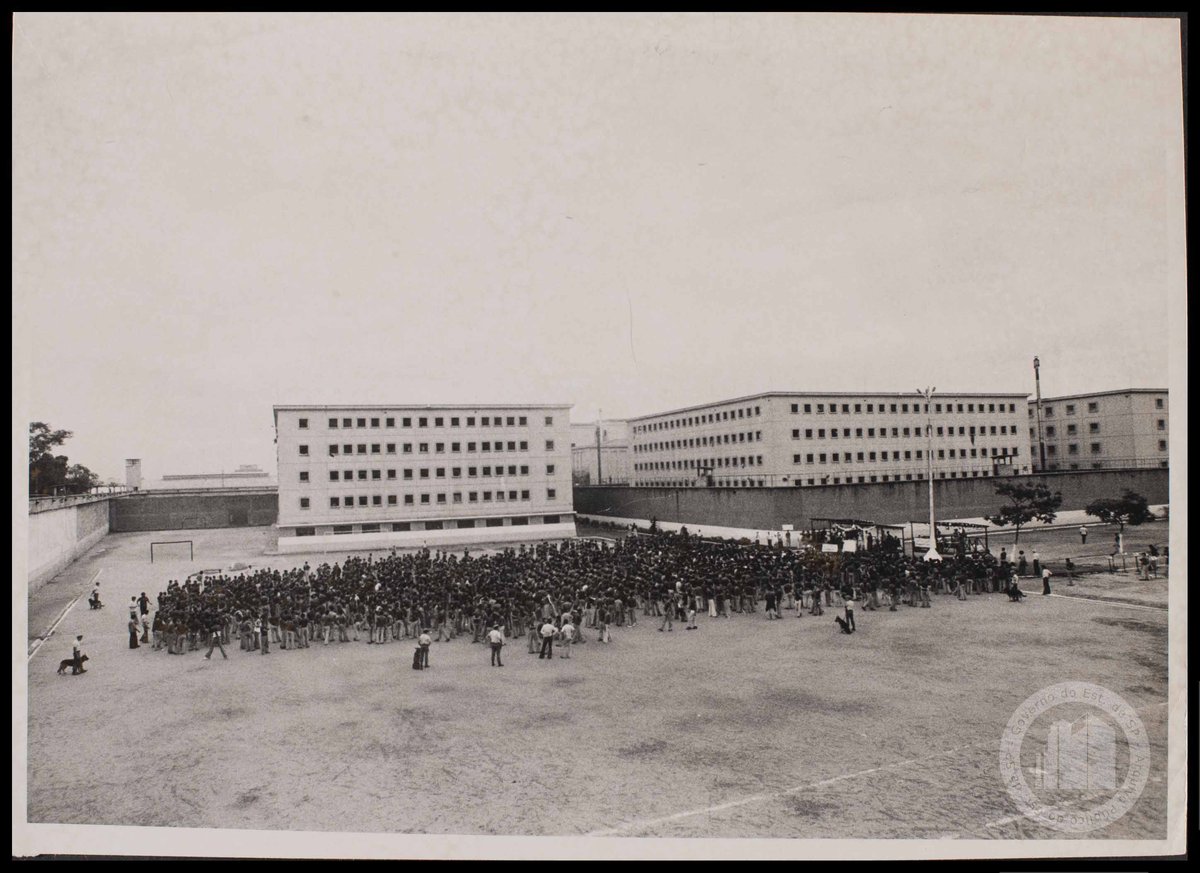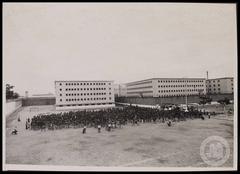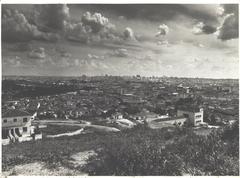
Carandiru Penitentiary Visiting Guide: São Paulo Historical Site Tickets & Hours
Date: 14/06/2025
Introduction: Carandiru’s Legacy and Visitor Experience
Carandiru Penitentiary, formerly known as Casa de Detenção de São Paulo, stands as a profound symbol in Brazil’s social and penal history. Once the largest prison in Latin America, Carandiru’s story is marked by its architectural ambition, notorious overcrowding, the tragic 1992 massacre, and, ultimately, its transformation into a vibrant urban park and museum. Today, the site invites visitors to reflect on justice, memory, and renewal within São Paulo’s dynamic landscape (BBC News; The Guardian; Human Rights Watch).
This guide provides comprehensive information on Carandiru’s historical significance, practical visitor details, cultural highlights, and travel tips for making the most of your visit to one of São Paulo’s most compelling historical landmarks.
Table of Contents
- History and Significance
- Parque da Juventude: Urban Renewal
- Museu Penitenciário Paulista
- Visiting Information
- Nearby Attractions
- Photo Opportunities
- FAQs
- Tips for a Meaningful Visit
- Conclusion & Recommendations
- Official Sources & Further Reading
History and Significance
Origins and Construction
Carandiru Penitentiary opened in 1920, designed by architect Samuel das Neves. It was intended as a modern correctional facility, initially housing around 1,200 inmates in spacious blocks with courtyards and administrative buildings. The facility reflected early 20th-century ideals of rehabilitation and humane incarceration (BBC News).
Overcrowding and Conditions
By the 1970s and 1980s, Carandiru had become the most populated prison in Latin America, holding over 8,000 inmates—far exceeding its original capacity. Overcrowding led to dire conditions: poor sanitation, rampant disease, limited healthcare, and frequent violence. Inmate factions gained control over many aspects of daily life, creating a volatile environment (The Guardian; Al Jazeera).
The Carandiru Massacre
On October 2, 1992, a riot in Pavilion 9 escalated when the São Paulo Military Police intervened, resulting in the deaths of 111 inmates. The massacre became a symbol of the systemic failures in Brazil’s penal system and brought international condemnation, serving as a catalyst for debates on human rights and prison reform (Human Rights Watch).
Closure and Transformation
The prison was closed and demolished in 2002. Its grounds were redeveloped as Parque da Juventude and the Museu Penitenciário Paulista, merging remembrance with community recreation and cultural education (SP City; São Paulo Secreto).
Parque da Juventude: Urban Renewal
Design and Layout
Inaugurated in 2003, Parque da Juventude covers 240,000 square meters and is divided into three main sectors:
- Sports Park: Multi-sport courts, tennis courts, skate and roller tracks, jogging paths, and free sports classes.
- Central Park: Gardens, tree-lined avenues, and remnants of the old prison, including preserved walls and watchtowers.
- Institutional Park: Home to the São Paulo Library, technical school, and digital inclusion center, representing the site’s transformation from incarceration to education (Area Arch).
Preservation of Memory
Elements of the original prison, such as sections of wall and watchtowers, are preserved as historical markers. Walkways and decks allow visitors to contemplate the site’s past while enjoying its new purpose. The landscape architecture fosters a dialogue between memory and renewal (São Paulo Secreto).
Cultural and Recreational Activities
The park is a hub for concerts, art exhibitions, festivals, and community events. Its proximity to the Carandiru metro station (Blue Line) and integration into the city’s cycling network make it accessible and popular among both locals and tourists.
Museu Penitenciário Paulista
Origins and Mission
Founded in 1939 and opened to the public in 2014, the museum documents the history of Carandiru and the evolution of São Paulo’s penal system. Its mission is to provoke reflection on justice, social rehabilitation, and the relationship between individuals and society (SP City).
Exhibitions and Collections
- Historical Documents & Photos: Chronicling Carandiru’s development, infamous events, and daily prison life.
- Inmate Art and Craftwork: Paintings, sculptures, and objects made in prison workshops.
- Contraband & Improvised Tools: Weapons, tattoo machines, and smuggling devices highlight inmate ingenuity.
- Punitive Cells: Preserved solitary confinement cells offer a glimpse into punitive practices of the past (Olaviajantes).
Visitor Information
- Location: Avenida Zaki Narchi, 1207, Carandiru, São Paulo, SP, 02029-001
- Hours: Monday–Friday, 09:00–16:00; closed weekends. Check the museum’s blog for updates.
- Admission: Free; no tickets required. Guided tours can be booked in advance.
- Facilities: Accessible by metro (Carandiru Station), with ramps and accessible restrooms. Some exhibits, like Pavilion 4, require advance booking.
Visiting Information
Hours & Tickets
- Parque da Juventude: Open daily, early morning to late evening.
- Museu Penitenciário Paulista: Monday–Friday, 09:00–16:00.
- Admission: Free for both sites. Guided tours at the museum are recommended and can be booked in advance.
How to Get There
- By Metro: Carandiru Station (Line 1 – Blue), a short walk from both park and museum.
- By Bus: Several city bus lines stop nearby.
- Parking: Available in the Santana district, but public transportation is recommended due to traffic.
Accessibility
Both the park and museum are wheelchair accessible. Assistance is available upon request, and paved paths facilitate access throughout the area.
Guided Tours & Events
- Museum: Guided tours provide deep historical context; advance booking is advisable.
- Park: Check the cultural calendar for concerts, art exhibitions, and festivals (São Paulo Secreto).
Nearby Attractions
- Santana Shopping Center: For dining and shopping.
- Museu da Língua Portuguesa: Museum of the Portuguese Language, a short metro ride away.
- Pinacoteca do Estado: São Paulo’s renowned art museum, easily accessible via metro.
Photo Opportunities
- Preserved prison walls and watchtowers
- Memorials and plaques commemorating the 1992 massacre
- Lush green spaces and modern recreational facilities in Parque da Juventude
FAQs
Q: What are the Carandiru visiting hours for Parque da Juventude and the museum?
A: The park is open daily from early morning until late evening. The museum is open Monday to Friday, 09:00–16:00, and closed weekends. Verify on the official museum blog for updates.
Q: Are there any admission fees or tickets required?
A: Both sites are free; no tickets needed. Guided museum tours can be booked in advance.
Q: Is the site accessible for people with disabilities?
A: Yes, both the park and museum are wheelchair accessible.
Q: Are guided tours available?
A: Yes. Guided tours at the museum are highly recommended and should be booked in advance.
Q: Can I take photographs?
A: Photography is allowed in most areas, though some museum exhibits may have restrictions.
Q: Is Parque da Juventude suitable for families?
A: Absolutely. The park features sports areas, green spaces, and cultural programming for all ages.
Q: How do I get there by public transportation?
A: Use the Carandiru metro station (Blue Line); both sites are within walking distance.
Q: Can I visit preserved prison structures?
A: Yes. Ruins and historical markers are integrated into the park’s design for educational purposes.
Tips for a Meaningful Visit
- Combine Experiences: Visit both the park and the museum for a full perspective on Carandiru’s transformation.
- Plan Ahead: Check for special events, guided tour schedules, and any changes in opening hours.
- Approach with Respect: The site holds deep historical and emotional significance. Maintain a respectful attitude, especially at memorial areas.
- Stay Informed: Download the Audiala app for self-guided audio tours, maps, and updates.
Conclusion & Recommendations
Carandiru Penitentiary’s story—from a symbol of incarceration and tragedy to a community hub and memorial—offers visitors a powerful journey through Brazil’s history of justice, resilience, and hope. Its transformation into Parque da Juventude and the Museu Penitenciário Paulista provides a unique opportunity to reflect on the past while engaging with São Paulo’s contemporary cultural scene.
Plan your visit by checking official schedules, booking guided tours, and exploring nearby attractions. Carandiru stands not just as a site of remembrance, but as an emblem of urban renewal and the enduring quest for social justice.
Official Sources & Further Reading
- BBC News: Carandiru Penitentiary History
- The Guardian: Carandiru Massacre
- Human Rights Watch: Carandiru Massacre Convictions
- Explore Carandiru: Visiting Hours, Tickets, and Historical Highlights of São Paulo’s Iconic Site
- Carandiru Penitentiary (Wikipedia)
- Museu Penitenciário Paulista and Parque da Juventude Information
- Parque da Juventude Urban Renewal Project
- Urban Design and Library at Parque da Juventude





































































































































































